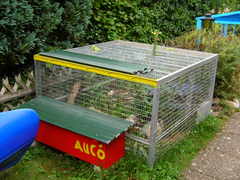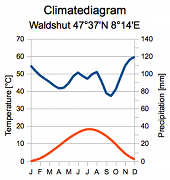
The Degu Outdoor Enclosure Project
The Project
Since autumn 2009 my degus pass the warm seasons (April-November) in a 2,5 square-metre outdoor enclosure. A shelter provides protection against rain, cold and wind. The soil consists of sand and humus and is covered with sparse vegetation. The vegetation is influenced by the weather, but it is also clipped and altered by the degus. Several invertebrates (snails, slugs, ants, beetles and insects, etc.) cohabit with the degus. The weather heavily influences the daily activity of degus and the current plant growth. The degus show a clearly different behaviour in comparision to indoor conditions. They have a more balanced behaviour, spend more time for resting and take advantage from the wider space and the more diverse structure of the cage. They also profit from a more natural diet - I offer them several kind of fresh plants like wild herbs, pasture plants, fresh flowers, grasses, branches with fresh leaves, but also whole nuts and several small seeds (in particular bird seeds).
Project Overview
| Duration | 2009-2011 |
| No. of degus | 2-4 |
| Dimensions | 1,5 x 1,5 m outdoor part, 1,0 x 0,3 m shelter |
| Soil | sand and soil mixture, barks |
| Structure | clay tubes, horizontal branches, rocks and stones |
| Construction outdoor part | metal wire (rabbit) cage, flooring comprised of wire mesh |
| Construction shelter | wooden walls protected with acrylic paint, aluminium roof |
| Climate | temperate, moderate continental |
| Location | Leibstadt (47° 35' 30"N, 8° 10' 30"E), Switzerland, about 50 km east of Basel. A small, rural village close to the german frontier. |
| Geography | Rhine Valley, between Basel and Lake Constance |
Table 1. Overview and some general data about the outdoor enclosure.
The Degus
The number and individuals living in the enclosure changed during the time. At the beginning the group consisted of three females and a neutered male (Raschel, 12/2004 - 04/2010). Two of the female degus lived for a long time in the enclosure, Clio (Clio 12/2004 - 10/2011) and Vana (spring 2005 - 11/2011), the third female (Uma, spring 2004 - 01/2010) lived only for a season in the enclosure.
Climate and Seasons
Leibstadt lies northern of the Alpes in the hilly lowlands at around 350 m altitude. The climate is temperate and influenced by oceanic winds. Precipitation level vary between 75 and 120 mm/month (1155 mm/year) with a main peak in winter and a minor peak in summer. Monthly average temperature ranges between 0 °C in winter and about 20 °C in summer. Late autumn and winter is dominated by high fog.
Precipitation [mm/month] and Temperature [°C]
|
|
Climate data follow the data from the "Deutsche Wetterdienst" (DWD) for Waldshut (Germany, 47°37'N, 8°14'E, 330 m altitude) and the years 1961-1990. Waldshut is a small town 5 km NE of Leibstadt and close to the Swiss frontier.
Spring to autumn
From spring to autumn the weather often is affected by alternating phases of dry and wet phases with a lenght of a few days to several weeks or even months. While long dry phases can dry out unirrigated plantings and even parts of the wild vegetation, the wet phases can lead to flooding.
Dry phase
The following photographs are taken in the dry spring 2011 (left, middle) and in autumn 2009 (right). The photos show plant growth is sparse aside from the young walnut trees.
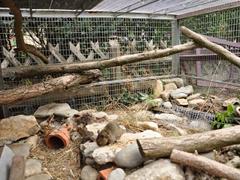
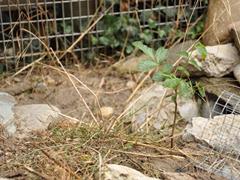
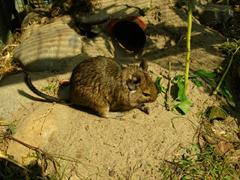
Wet phase
The following photographs are taken in the early spring 2011 (left) and in autumn 2009 (middle, right).
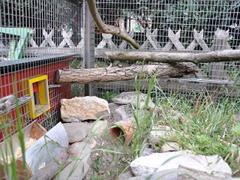
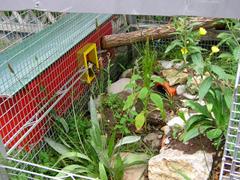
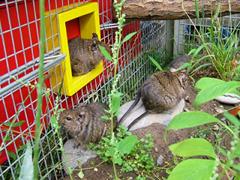
Winter
Winters normally are moderate and snow is scarce. However winters sometimes are influenced by heavy snowfall events. Between 2009 and 2011 were two consecutive winters with heavy snowfalls. I normally tooks my degus indoors before the first snowfall, but in November 2010 I was surprised by sudden and heavy snowfall.
(Photos November and December 2010)
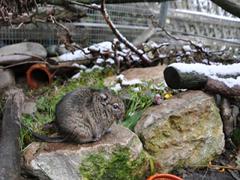
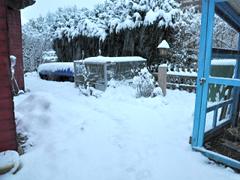
Ecosystem in the Garden
The limited size of the enclosure concentrates the activity of the degus. It becomes obvious that not only the environment (weather, temperature, plant growth) influences the degus, but vice versa the degus influences their environment too and creating living space for insects and invertebrates. They clip and gnaw down the herbs and grasses, remove shrub seedlings and ivy tendrils growing in the enclosure. Only the walnut seedlings are the ones of the few plants degus ignore mainly. While most plants suffer strong herbivory, the insect and invertebrate fauna (bugs, cockroaches, ants, slugs, snails, spiders) take advantage from dried leaves and food debris. They provide ample food as well as structure and diverse microhabitats, and thus suitable niches for the invertebrates. But the degus don't care about this small animals and ignore them. Neverthless during the wet periods slugs sometimes invade the enclosure in large quantities, so that they have to be removed manually.
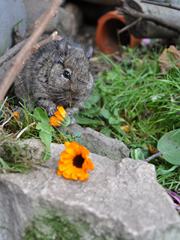
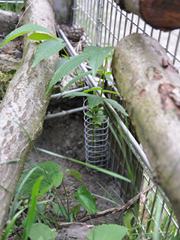
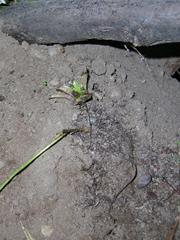
Making of
During spring and summer 2009 the cage was renovated, soil and structure shaped, several plants grown from seeds and a wodden shelter built. In September the enclosure was ready and the degus moved in.
Cage renovation
At the beginning was a rosty metall mash cage, I had to clean first. For the cage structure modelling a huge amount of sand and stones was needed:
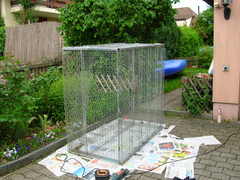
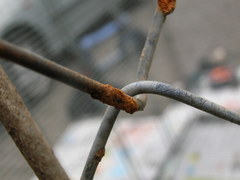
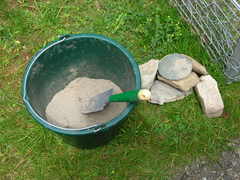
Plant nursing and planting
Green plants for the enclosure setting. Herbs and weeds like dandelion or plantain are germinated from seeds. Sand is used for the soil and shaping an interesting area decorated with stones and plants.
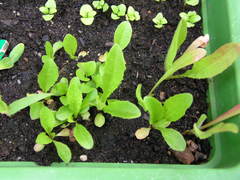
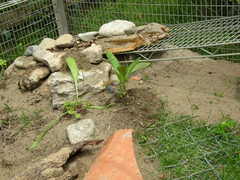
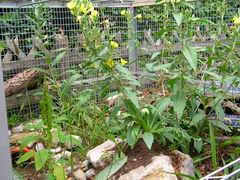
Construction of the shelter
The shelter has two areas, a small one with straw and clay insulation and a bigger one consisting only of wodden walls. An aluminium roof protects the shelter against rain and moisture:
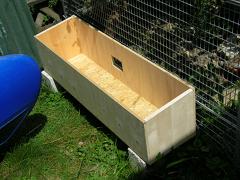
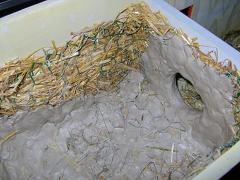
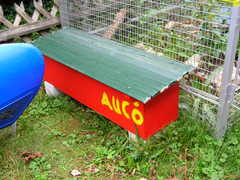
Feeding and activity
The way of feeding degus is a crucial issue for such a semi-natural keeping approach. I strongly focus on green food stuff, mainly fresh herbs, grasses and flowers, enriched with seeds (birdseed mixtures), branches and fresh twigs. Herbal food is of importance because it provides an enriching structure (in sens of food enrichment) and it has also a occupational effect: the animals have to work for their food. This agrees with findings form studies in wild: foraging and feeding makes up to 46 % of the degus daily activities, followed by vigilance (32 %), resting (8 %) and locomotion (7 %) (Ebensperger & Hurtado 2005).
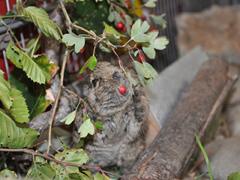
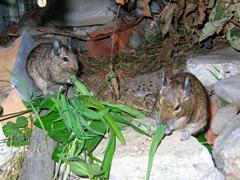
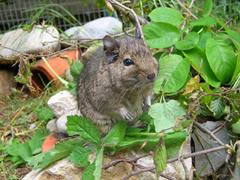
In 2011 I tried out a wooden running saucer for running activities, but it was sensitive to the weather (especially rain/moisture), thus offered it only occasionally and also the degus seemed to ignore it almost entirely. In contrast they loved horizontal thick branches and used them to monitor the environment or just to take a sun bath.
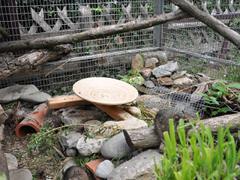
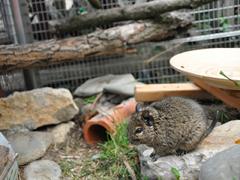
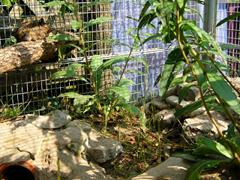
My experience
The construction of a degu save and predator proof enclosure needs a good preparation and careful realisation. It is costly and needs much time. It needs appropriate climate conditions. Degus have to be tame to enable a stressless and easy handling. Maintainance is easy. There is low effort for cleaning and maintainance. The enclosure works as a partly selfsustaining system. Main tasks are feeding, and from time to time cleaning the shelter, removing old food and reparation/renewal of enclosure structure.
This form of degu keeping is suitable for long term keeping and needs a suitable place outdoors. High initial costs are exceeded by long term advantages. Outdoor enclosures are not recommendable for beginners because experience is needed for a good implementation. Especially winter outdoor keeping is delicate and needs a good preparation.
Further Readings and Publications
cited work:
- Ebensperger, L.A. Hurtado, M.J. (2005): Seasonal changes in the time budget of degus, Octodon degus. Behaviour 142: 91-112.
own work (in german):
- Küpfer, D. (2010): Erfahrungen mit der Außenhaltung von Degus. Rodentia, Nager & Co. 54: 42-45.
- Küpfer, D. (2011): Bau eines Außengeheges für Degus. Mitteilungen der BAG Kleinsäuger 1/2011: 18-21.
- Küpfer, D. (in prep.): Die Rentner-WG im Garten. Rodentia.
Videos
The following videos give a small overview about the life of the degus in their outdoor enclosure. You can find a more comprehensive list on youtube: www.youtube.com/user/degupediaDE
Text: David Küpfer, January 2012
